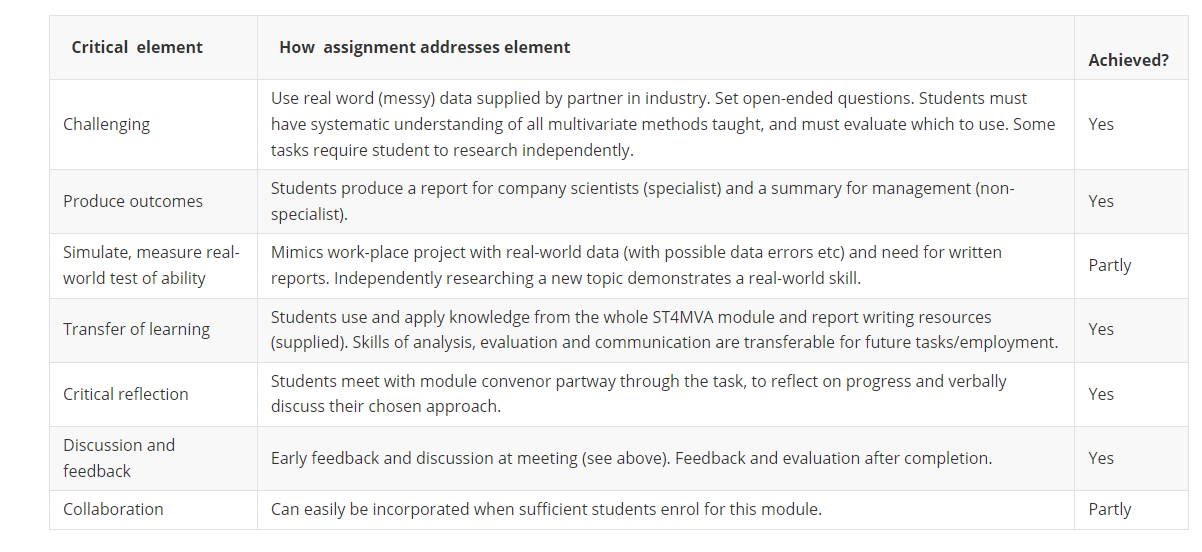By: Dr Julia Abery, Department of Mathematics and Statistics, j.abery@reading.ac.uk

Photo by Mimi Thian on Unsplash
Overview
I designed a tailored applied statistics assignment for a UoR Part 4 Department of Mathematics and Statistics module (module code ST4MVA) which successfully met two distinct objectives. Firstly, the assignment tested advanced, specific masters-level skills, as outlined in the QAA framework. Secondly, the assignment incorporated the critical elements of authentic assessment as recommended by Ashford-Rowe et al. (2014).
Objectives
In designing the assessment, the objectives were as follows:
- To test masters-level skills described in the QAA L7 descriptor and to conform to departmental guidelines for L7 assessment.
- To align with the ALOs (assessable learning outcomes) of the Part 4 applied statistics module ST4MVA.
- To incorporate the critical elements of an authentic assessment, aiming to improve student engagement and develop employability skills.
Context
I produced a Part 4 assessment in multivariate methods which tests specific, advanced level 7 skills including systematic subject knowledge, evaluation, analysis, creation and independent research, to align with our department’s aims for assessment at this level.
Following discussion with colleagues and students, I became persuaded that an authentic assessment could increase value and meaning to the student. This meant basing the assessment on engaging ‘real-world’ scenarios, and aiming to incorporate employability skills and to promote deeper learning approaches.
Implementation
I consulted ST4MVA ALOs and departmental guidelines for Part 4 assessment, and decided on a data analysis assignment requiring selection and implementation of a range of multivariate methods in the statistical computing package R, some of which are researched independently. I took direction from the QAA level 7 descriptor; ‘to deal with complex issues both systematically and creatively … communicate their conclusions clearly to specialist and non-specialist audiences; demonstrate self-direction and originality in tackling and solving problems, and act autonomously in planning and implementing tasks at a professional or equivalent level.’ I designed an open ended task, so students could be creative and direct their own work. I requested two written reports, for specialist and non-specialist audiences.
Having reviewed various articles, I elected to use a simplified version of Ashford-Rowe et al.’s (2014) list of critical elements of authentic assessment. The table below shows how the assignment addresses these elements.

Select here to download an accessible version of this table.
Impact
Feedback from internal and external examiners and other colleagues suggests the assignment successfully captures features of an authentic assessment and allows students to demonstrate higher level abilities and employability skills. Some colleagues thought a similar approach might be used elsewhere in our programmes. Writing an assignment with close alignment to the principles of authentic assessment was instructive and will undoubtedly influence the way I approach assessment in other modules and at other levels.
Students reported that the tasks were genuinely useful ones to practise and master, and tested higher level skills such as evaluation, creativity and analysis. The assignment was felt to be challenging and at least moderately engaging and interesting. One student commented ‘being able to apply the techniques we had learnt in lectures onto “real world data” made it very applicable to a real-world scenario[s].’
Reflections
At least three features helped to ensure success: Firstly, obtaining data from an industry partner, and working on the project with them, helped to maintain a real-world focus and ensured employability skills were assessed. Secondly, detailed scrutiny of the assignment by experienced internal and external examiners resulted in making some changes and improvements which led to a better and more challenging assignment. This highlights the benefits of collaborating with colleagues and other academics when developing authentic assessment, and being open to constructive criticism. Thirdly, consulting the literature and identifying a checklist ensured that I had clear objectives and maintained a wide perspective on different aspects of authentic assessment.
On reflection, a fuller understanding of authentic assessment may be achieved by consulting local employers, identifying skills they look for when they recruit and checking whether assessments align well with these. More feedback from students would be beneficial, clarifying the extent to which claims in the literature of enhanced learning, increased engagement and motivation play out in students’ experience.
The assessment has now been released, completed and marked but only for a small number of students to date, meaning that a full evaluation is yet to happen. A possible extension of the practice would be to implement authentic assessment at programme level – so each student can benefit.
References
- Ashford-Rowe, K., Herrington, J., and Brown, C. (2014). Establishing the critical elements that determine authentic assessment. Assessment and Evaluation in Higher Education, 39(2), pp. 205–222. https://www.tandfonline.com/doi/full/10.1080/02602938.2013.819566
- QAA. (2014). UK Quality Code for Higher Education Part A: Setting and Maintaining Academic Standards. The Frameworks for Higher Education Qualifications of UK Degree-Awarding Bodies. https://www.qaa.ac.uk/docs/qaa/quality-code/qualifications-frameworks.pdf